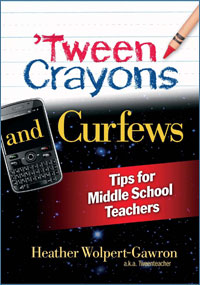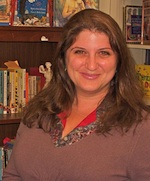Those Beautiful Howler Monkeys
Two Reviews of One Book
‘Tween Crayons and Curfews: Tips for Middle School Teachers
by Heather Wolpert-Gawron
(Eye on Education/Routledge, 2011 – Learn more)
As a middle school teacher, I have to admit I was tingly with excitement to receive my reviewer’s copy of ‘Tween Crayons and Curfews: Tips for Middle School Teachers by Heather Wolpert-Gawron, the “Tweenteacher” herself. Having read Ms. Wolpert-Gawron’s blog for years, I have on numerous occasions whispered to myself, “She gets me. She really gets me.”
So having the opportunity to read about “the pride and enjoyment of working with this energetic and ever-changing group of students” (as described by Milton Chen, PhD in the foreword) put me right in my element, and ‘Tween Crayons and Curfews didn’t disappoint.
I was hooked from the beginning, the introduction actually, when Ms. Wolpert-Gawron opened by describing middle school kids. This is a definition that, in my experience, has defied words. All the clichés are out there – “hormones on wheels,” for example – but they don’t quite capture the Tween kid like these words: HOWLER MONKEY. Yes, in a beautiful analogy that involves caterpillars and butterflies, the Tweenteacher encapsulated that which is the middle school child.I had to read the rest.
The rest is an amazing journey of the middle school experience – it begins with a trip into a “’tween-centric” classroom. I read this chapter and nodded up and down continuously. Here is a teacher in California describing a middle school classroom that looks and feels like my classroom in North Carolina, right down to the reading area and the work display! I felt some definite affirmation! But truly it took me over 20 years to internalize the practice of setting up my classroom in a way that works for Tweens. I couldn’t help but think of how this book could empower beginning teachers early in their careers.
Not just for beginners

And the tips just kept coming. From ideas for ways to rev up the Tween brain for learning…to strategies for enabling kids to look at, and reflect on, data so they know “who they are as learners,” ‘Tween Crayons and Curfews is a teacher handbook for teaching middle school. It was somewhere around the brain chapter (“Tips for Teaching Tweens about Their Brains and How They Learn”) that I realized a teacher could surely pick up this book and open anywhere and begin reading. It’s a manual, a guide for teaching, and each page holds secrets to mastering the arts of teaching Tweens!
Much in the book is relevant to other student groups, too. The chapter on making time meaningful could surely relate to those distracted high schoolers as well. I enjoyed reading the “possible responses” to that age old question, “Why do we have to learn this?” Ms. Wolpert-Gawron has accepted the challenge of answering the question that every teacher hears repeatedly, and like every other topic she tackles in the book, she does so thoughtfully, using reason and wit: “Our brain is a muscle and like any muscle in your body, it needs to be worked out before you can do any heavy lifting….”
Favorites and a few faux pas
Some of my favorite parts of the book? A section entitled “Typical Argument Traps” (is there a Tween teacher who doesn’t need to understand those?). And I love the personal stories that enable the reader to connect with her (did she really have an emergency appendectomy while studying at Oxford University?). Then there are those handy instructional strategies that the reader can use immediately (thinking aloud, quick draw, rubrics, a book-begging letter…the list goes on and on).
I can honestly say that I loved this book. It’s my new “go-to” book for teacher gifts and for beginning teacher meeting door prizes. The only negative remark I can even muster is the fact that one of my favorite television shows, Dancing with the Stars, is referred to as Dances with the Stars in chapter three, and there were a couple of typos in other places as well (one chapter is entitled “Tips for Speaking Their Language Though the Use of Social Media” in the table of contents). I bet everything was typed correctly in the draft, but one of those darn HOWLER MONKEYS got hold of the manuscript before it went to print.
Still, I finished this book with a smile on my face. And looking back, I started that way, too, while reading Ms. Wolpert-Gawron’s description of herself as a Tween and answering the questionnaire “Who were you in middle school?” that she included in the introduction. I have to say those answers took me back a LONG way. And that journey, like the book, was a fun and educational trip.
Cindi Rigsbee began her career as a high school English and drama teacher but quickly found that her heart belonged to the Howler Monkeys; she has taught 1,000s of them in the past 25 years. A National Board Certified Teacher and proud member of the Teacher Leaders Network, Cindi is currently on loan from Gravelly Hill Middle School to the North Carolina Department of Public Instruction. The North Carolina Teacher of the Year in 2009, Cindi was named a finalist for National Teacher of the Year. Her book Finding Mrs. Warnecke: The Difference Teachers Make tells the story of finding her first grade teacher 45 years after an exciting adventure in an elementary school basement. You can find Cindi at cindirigsbee.com.
Another review of. . .
‘Tween Crayons and Curfews: Tips for Middle School Teachers
by Heather Wolpert-Gawron
(Eye on Education/Routledge, 2011 – Learn more)
As a fellow middle school educator (or ‘tween teacher as Heather Wolpert-Gawron nicknames herself), I am always eager for new ways to reach my middle school students. I often wonder what teaching strategies and classroom helpful hints are out there to provide help for me and make life in school more interesting for all of us.
My students, who are not only ‘tweens, but learning disabled, have attention challenges, reading and writing disabilities, health disabilities, are on the Autism Spectrum, and often don’t feel positive about themselves when it comes to learning. As a special education co-teacher working with 4 general education colleagues, I worry if these students are just plain frustrated because they aren’t grasping what my teammates and I are hoping for them to achieve: a successful middle school experience.
Heather has provided a practical guide for us: it’s full of tips and real-life stories from her classroom as well as some useful downloads and technology-oriented tools, crucial in this era of teaching digital learners. Her book is broken down into 15 chapters ranging from How to Develop A Tween-Centric Classroom Library for Any Subject, Keeping Their Time Meaningful, Speaking Their Language Through the Use of Social Media, and my favorite: Tips for Teaching Deeper Thinking.
Ideas for newbies and veterans alike
The beauty of this guide (because it’s more than a book) is that a teacher can skip around and pick topics that are most important as they develop a plan for the fall, or face an urgent situation during the school year. Although my 23rd First Day of Sixth Grade is approaching as I write this (24th if you count my own!), I am already looking forward to using Heather’s ideas from Chapter 6 on Tips for Teaching Deeper Thinking.
Here she shares the concept of Thinking Aloud, something so critical to us as teachers when we ask students what they learned the previous day — or if they have any questions — and we’re met with a wall of silence or a fence with Nothing scrawled on it. We know they have questions, but as Heather so eloquently states, “Their brains are always on, always working, always questioning, always relating. More often than not, these students just don’t know how to express or retrieve the fleeting thoughts they have.”
Many of us use the Think Aloud strategy when reading novels, but not so much in the situation she describes. Heather first shares the idea of metacognition, or “thinking about thinking,” with her students. Then she models it. First she responds to a writing prompt on her overhead, then she sketches thought bubbles to show what’s on her mind as she’s writing. Then she may put voice to her thinking. I will utilize this strategy in my academic support class to demonstrate how writers go about the writing process — something that all my students struggle with.
A small sample
Another favorite idea I look forward to using as I introduce myself to my students the first day is a variation of “Two Truths and a Lie.” When Heather was in the California Summer Writing Project she observed Erick Gordon using an activity called “Find the Fib.” She writes a list of 10 facts about herself, and the kids have to guess which one is a fib. For each one they guess is true, she shares one minute of a story. She then finishes this as a segue into a memoir or narrative writing activity. What a great way to introduce yourself to your students AND guide them in the writing process. Plus it’s fun!
This is a small sample of what’s in store if you decide to stage your own scavenger hunt inside Heather Wolpert Gawron’s very useful and entertaining book. Need some new ideas for the upcoming school year? A tween-brain-friendly lesson? Some basic insight into what researchers say about the thinking, feeling and acting coming out of that brain? A few more ways to excite and motivate young adolescents in your middle grades classroom?
In every case, ‘Tween Crayons and Curfews is the book for you.
Laurie Wasserman is a Nationally Board Certified 6th-grade special needs teacher in a city just north of Boston, Massachusetts. She has been teaching for 32 years, has written articles for Education Week, Teacher Magazine and Education World, all about her love of working with kids who “learn differently.” She is also a co-author of the 2011 book Teaching 2030: What We Must Do for Our Students and Public Schools Now and in the Future. Laurie is a member of the Boston Writing Project, and Teacher Leaders Network, as well as a new teacher mentor. Later this fall she will co-author a new MiddleWeb blog about the co-teaching experience.




































